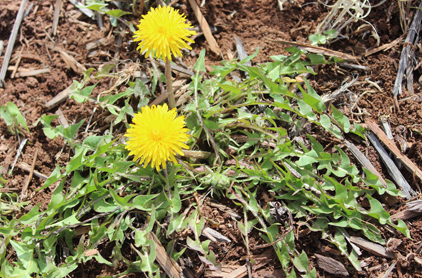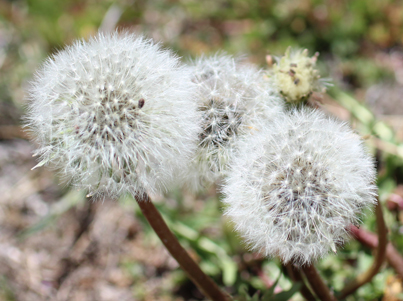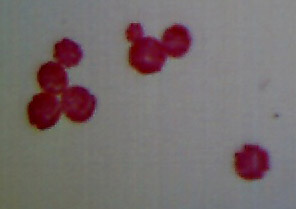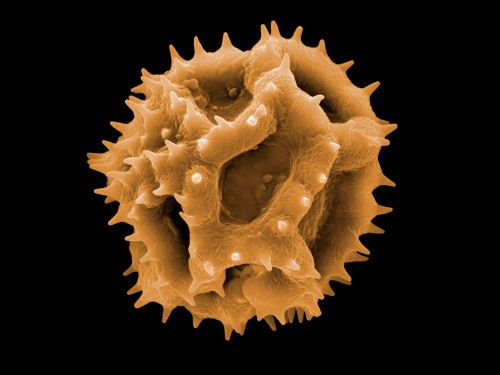
1. In front of Visitor Center (GPS-N35D33'01.3677 X W105D41'10.061)
2. All along the trail
Flowers first observed: 3/20/17
The Plant w/Flowers

The Flower
Seed Heads

The Pollen
 |
 |
400X (43µm) |
Distribution
The common dandelion, taraxacum officinale, was introduced from Europe and has spread all across the US. (American Southwest.net)
Description
"The common dandelion, taraxacum officinale, was introduced from Europe and has spread all across the US. The yellow flower heads, 1.5 inches in diameter, consist of between 40 and 100 narrow ray petals, forming a semi-sphere when fully in bloom. Petals have straight edges and a notch on the tip. Beneath the petals are green bracts, curling back towards the unbranched, hollow stem, which contains milky sap. The flowers are followed by thin, feathery seeds that angle in all directions to form a complete sphere. Leaves grow only around the base." (American Southwest.net)
Ethnobotanical Uses
Food:
"Leaves, flowers, buds, young stalks, and roots are edible raw or cooked. Dandelions are bitter, but often pleasantly so. Best to pick leaves before the flowers appear. Leaves are somewhat less bitter when young but can be eaten when older as well. Tight, unfurled crowns, at ground level in the middle of the rosette are also tender and edible. To best enjoy the flowers, remove them from the green bracts, although this isn't necessary.
Roots are best eaten when they are young enough to be uniformly whitish throughout, except for the darker skin. Older roots become tougher and darker in the center. Both old and younger roots can be roasted and used for dandelion 'coffee.'" (Morgan 57)
"Gather 1 gallon of dandelion flowers on a dry day. Put these in a 2-gallon crock and pour 1 gallon of boiling water over them. Cover the jar and allow the flowers to steep for 3 days. Strain through a jelly cloth so you can squeeze all the liquid from the flowers. Put the liquid in a kettle, add 1 small ginger root, the thinly pared peels and the juice of 3 oranges and 1 lemon. Stir in 3 pounds of sugar and boil gently for 20 minutes. Return the liquid to the crock and allow it to cool until barely lukewarm. Spread 1/2 cake of yeast on a piece of toasted rye bread and float it on top. Cover the crock with a cloth and keep in a warm room for 6 days. Then strain off the wine into a gallon jug, corking it loosely with a wad of cotton. Keep in a dark place for 3 weeks, then carefully decant into a bottle and cap or cork tightly. Don't touch it until Christmas or later." (Gibbons Stalking 81-2)
Recipe 1: Fresh Greens Salad
"I like to prepare hardy wild greens in what I call 'salad seviche.' There's no fish, but the preparation is similar. Prepare an oil-and-vinegar salad dressing. Combine 1 tablespoon olive oil, 1/2 tablespoon vinegar, and the juice of 1 fresh lemon or lime. Add a splash of soy sauce. Mix well until emulsified.
Wash and then chop 4 cups dandelion greens. Place greens in bowl, and pour dressing over them. Toss well. Set aside and allow to sit for 30 minutes. Just as the vinegar and citrus 'cook' raw fish in the Spanish dish seviche, the combination also tenderizes the hardy greens, making them more tender and enjoyable to eat. Just before serving, toss in about 4 cups lettuce of your choice..
Variation: Add pan-fried strips of grass-fed steak.
Recipe 2: Bacon Fried Young Greens
"This is a very hardy breakfast, good before a day of serious lumberjacking.
Harvest 1 cup young dandelion shoots, stalks, and leaves; wash in cool water to remove any dirt. Chop roughly into strips, and steam n a steamer about 7 minutes until just wilted; set aside.
Cook some good-quality bacon in a heavy skillet. When bacon begins to crisp, remove it and set aside, leaving about 2 tablespoons of the bacon grease in the pan.
Add the steamed greens to the skillet, and pan-fry on high heat until just beginning to crisp but not burn. Remove from heat; add crumbled bacon and a bit of fresh-ground pepper. Serve on a big bed of warm rice with a dash of soy sauce and a sprinkle of flax seeds." (Morgan 58)
"Leaves, root, and flower. Dandelion leaves can be added to a salad or cooked. They can also be dried and stored for the winter or blanched and frozen. Flowers can be made into juice, or added into many recipes. The root can be made into a coffee substitute. The root and leaves can be dried, stored and made into tea." (Edible Wild Food)
Medicine:
"Dandelions are rich in vitamins A,C,E and B-complex, iron, calcium and potassium. Dandelion root or leaf tea was recommended as a mild laxative that would also stimulate urination, salivation and the secretion of gastric juices and bile, improve appetite and generally tone the whole system. It has been used to treat liver, urinary tract and digestive problems. The roots have been reported to lower blood sugar and cholesterol levels, to lower blood pressure, to reduce inflammation, to have anti-microbial effects (against Candida albicans in particular) and to aid weight loss. They also contain the sugar inulin, which is said to be an immune-system stimulant. Historically, dandelion flowers were used to treat jaundice and other liver ailments, perhaps because of their yellow color,. Recently, they have been shown to contain large amounts of lecithin, which has been shown to prevent cirrhosis in chimpanzees. The milky juice, applied 3 time daily for 7-10 days, was said to kill warts." (Kershaw 162)
"There is virtually no toxic potential to Dandelion, and large quantities may be drunk. This is necessary in such traditional uses as dissolving urinary stones and gravel, where up to an ounce of the chopped root is boiled and drunk in several doses during a day, or two tablespoons of the tincture are drunk in water twice a day. This should be done for at least ten days. The root in tea will have little effect on constipation due to nervousness, diet, fevers, and such occasional causes, but acts reliably when it is chronic, related to age long-term illness, or general intestinal blahs; a teaspoon of the root boiled in water three or four times a day."(Moore 69-70)
Internet Links